Integration by Parts, In Your Head
Integration by Parts, In Your Head
Integration By Parts
This chapter explains how to mentally do integrations which must be solved by integration by parts. As you read, it may seem that you have to keep an unreasonable amount of information in your head. ``How am I supposed to keep track of all this? It's not possible.'' What you are learning to do is work with your internal representation of the math. If you visualize an equation, that is one possible internal representation. The more efficient the representations you employ inside of you, and the more efficient your methods for working with them, the more complex the math you can easily do. One thing talented mathematicians have working for them is that they have discovered how to internally represent math expressions in ways that are both efficient and amendable to mathematical manipulation. This lets them use the mental energy they have very, very effectively. As mentioned earlier, if a person's ability to visualize is good enough, they can just imagine a whiteboard in their mind's eye, and imagine each step written out exactly as they would write it out on a real whiteboard. That's certainly one possible internal representation, and one that requires a LOT of mental work! Mathematicians learn to represent expressions in more minimal ways, making them much easier to manage. That is precisely what you are learning to do here!
Ease into it gradually. Use the techniques to skip single steps that you would normally write out. For a problem that you might typically write six steps to solve, do one of them mentally and write five steps. After you have done this enough that it seems straightforward, look for opportunities to do two steps in a row mentally. Bite off what you can chew. It's very likely that there will be times when you attempt to do something mentally, and partway through it discover that it was too much. No problem; I do that all the time. So does every mathematician and engineer I know of. Just back off to where you started that step and write it out instead, or break it up into smaller, more manageable pieces.
What's written below is presented in the most extreme case: how you would evaluate the whole expression mentally. You can always use it partially, writing out as many steps as needed. When evaluating a mathematical expression, the most important thing is to understand what you are doing. Do as much or as little mentally as it takes to support that goal.
Most modern calculus textbooks use the symbols u and v when teaching integration by parts. The equation you memorize is probably ![]() , not
, not ![]() , even though mathematically they are the same. In addition, the position of the symbols is always the same: you typically see and write the right hand side as
, even though mathematically they are the same. In addition, the position of the symbols is always the same: you typically see and write the right hand side as ![]() , and not like
, and not like ![]() or
or ![]() .
.
You can use this consistency to help you do integration by parts mentally. We'll demonstrate with the integral

First, you want to rearrange the symbols so that you can work with the expression more clearly. You might end up visualizing something like this:

In this form, the expression is organized in a more minimal way, and will be easier to work with.
(Note: while doing algebra mentally is not explicitly covered in this work, it can be done with the techniques covered in the first few sections - visualization, using chunks, and so on. The book Inner Algebra (http://hilomath.com/inneralgebra/html/), and the upcoming book Higher Mental Math, teach mental algebra in detail.)
When doing integration by parts, you divide the integrand into two parts - one of which will be differentiated, the other integrated. The next step is then to divide up the integrand and differential into two chunks like that:

This is what you might visualize. There are a few things to point out. We have mentally moved some of the symbols around. Also, we have decorated the chunks, by putting a little ``u'' or ``dv'' on top of them. You can actually visualize these labels over each chunk. Yet you don't have to: the other thing to notice is that we put the u chunk on the left and the dv chunk on the right. Now, as we mentioned earlier, when you learn integration by parts, typically the formula you use has a left-hand side of ![]() , rather than
, rather than ![]() . Even though mathematically both versions have the same meaning, you have made a habit of using the first form. (Or if you are taking your first calculus course right now, you will be taught to make it a habit.) You can exploit this habit; all you have to do is divide the expression into two chunks, and put the one corresponding to u on the left of the chunk corresponding to dv. So you can visualize the expression like this:
. Even though mathematically both versions have the same meaning, you have made a habit of using the first form. (Or if you are taking your first calculus course right now, you will be taught to make it a habit.) You can exploit this habit; all you have to do is divide the expression into two chunks, and put the one corresponding to u on the left of the chunk corresponding to dv. So you can visualize the expression like this:

While the chunks are not labelled, you know which is which by its position in the expression. The position itself acts as the label! Having fewer symbols, it is easier to visualize and work with mentally. The fewer symbols an expression has, and the simpler they are, the greater the ease with which you can work with that expression.
You can harness this positioning in a powerful, interesting way. Visualize the right side of the integration-by-parts rule:

Now, replace that with this image:

You are visualizing empty chunks, arranged in a pattern like the reference image. Obviously, each of these empty chunks corresponds to u, v, or dv. What you want to do is be able to switch between both images in your mind's eye. Practice this a few times right now.
So now you have two images you are working with: the first one, containing ![]() , and the second one, containing empty chunks. You mainly work with the second image, filling in the chunks. When you need to remember what goes in each chunk, you visualize the
, and the second one, containing empty chunks. You mainly work with the second image, filling in the chunks. When you need to remember what goes in each chunk, you visualize the ![]() image, so that each symbol (u, v, and dv) overlaps the chunk they correspond to. This can be done in a way that efficiently reminds you of the meaning of each chunk.
image, so that each symbol (u, v, and dv) overlaps the chunk they correspond to. This can be done in a way that efficiently reminds you of the meaning of each chunk.
Let's examine how this can be done with ![]() , step by step. Once you have sorted the expression into two chunks, visualize something like this:
, step by step. Once you have sorted the expression into two chunks, visualize something like this:

At any time, to remind yourself of the meaning of each chunk, you can replace that image with this one:

Swap between them in your mind's eyes. This may or may not be easy for you at first. If not, practice!
Since some of the chunks repeat - e.g., u and v both appear twice - you can just copy the chunks to those spaces. Moving left to right, you would first visualize
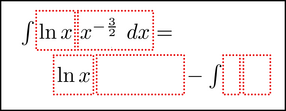
(This image is split up into two lines, so that it can fit on the page you are reading. As you visualize it internally, you can either keep it as one long line or split it up like this. If you do, you may want to split up the image of ![]() similarly.) We don't have to think much for this first substitution, since we are simply copying the contents of one chunk to another. Schematically, it works like this:
similarly.) We don't have to think much for this first substitution, since we are simply copying the contents of one chunk to another. Schematically, it works like this:

You are taking a part of the mental image you have, and reproducing it in another location. To fill the next chunk on the right hand side, you will have to integrate the contents of the dv chunk on the left-hand side. You would end up visualizing something like this:
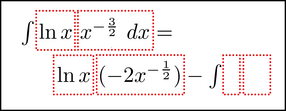
At this point, you can remind yourself of what to do next by swapping back to this image:

Since the ``v'' chunk appears twice on the right hand side, and we filled the first one, we know what to put in the second one. Switching back to the other image,
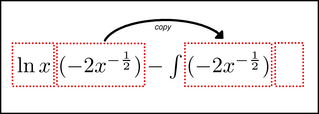
Note that we only visualize the right hand side here, since for this step that is all we need. Switching again to this image,

we see that the last chunk to fill is the differential of ![]() . While mental differentiation is not covered in this book, it is based on all the same principles you have learned so far. (Mental differentiation will be detailed in the upcoming book, Higher Mental Math.) Differentiating an expression is often easier than integrating it, fortunately. To finish, copy the u chunk, differentiate its contents, and move it into the last space:
. While mental differentiation is not covered in this book, it is based on all the same principles you have learned so far. (Mental differentiation will be detailed in the upcoming book, Higher Mental Math.) Differentiating an expression is often easier than integrating it, fortunately. To finish, copy the u chunk, differentiate its contents, and move it into the last space:
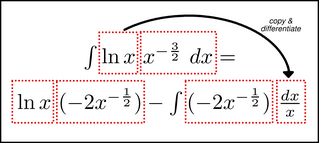
This is a good place to simplify the expression. If you intend to write down the final result, you can simplify and write down the first term on the right-hand side at this point. In fact, you can do it even before now, so that you have less to remember. Let's say you have done this - you have just written something like ![]() , and now you are visualizing this:
, and now you are visualizing this:

(This is all you have to visualize now, since you have written down the rest and have finished with it.) We still have the chunks there. At this point, though, we no longer need them. So just visualize the expression without them:

You can simplify it, and perhaps end up visualizing something like this:

To evaluate this mentally, first recognize that this expression fits the rule

(plus a constant, but since we are doing integration by parts, we can set this constant to 0.) To mentally integrate a monomial like this![]() , begin by visualizing the expression and chunking the exponent:
, begin by visualizing the expression and chunking the exponent:

Then, drop the integral sign and the differential dx from the image:

(By the way, this is what we call an intermediate image - an image you visualize that has no (correct) mathematical meaning, but is something you use as a step when moving from one valid image to another.) Now, add one to the exponent (the chunk's contents):

There is one more step, which can be done in a couple of ways. In the first way, you would make a fraction, copying the chunk and moving it into the denominator:

From this point you just de-chunk and simplify:

The second way for the last step also involves copying the chunk. But you don't create a fraction; instead, you invert the chunk's contents and insert it multiplicatively in the expression:
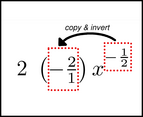
Then, you just de-chunk and simplify. Obviously, these are both mathematically the same. The second way is useful when the exponent is a fraction. The first way is better when the exponent is not a fraction. While you will use both, you will probably use the first way more often.
After all this talk about the internal process, it may be helpful to step back and see what all this looks like from the outside. If you are watching yourself, after you have learned and mastered these techniques, what would you be doing? Imagine you are evaluating an integral that is written on a whiteboard (or written on a sheet of paper, typed into a computer, etc.). You glance at the expression several times as you evaluate it. You may rewrite the expression once with the symbols sorted into two groups, u on the left and dv on the right. Or you may not rewrite it at all, relying on your mental image instead. You write an equal sign, followed by a term that corresponds to uv: it's a simplified expression, with the product of u and v reduced to its simplest form. Next you write an integral, whose argument corresponds to v du. Alternatively, you write the result of evaluating the integral directly, evaluating it internally first.
Footnotes
- ... this
![[*]](/usr/share/latex2html/icons/footnote.png)
- By extension, this works with polynomials also.